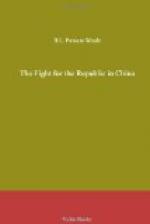On the memorable day of October 11, 1911, when the standard of revolt was raised at Wuchang, somewhat against his will as he was a loyal officer, he was elected military Governor, thus becoming the first real leader of the Republic. Within the space of ten days his leadership had secured the adhesion of fourteen provinces to the Republican cause; and though confronted by grave difficulties owing to insufficiency of equipment and military supplies, he fought the Northern soldiery for two months around Wuchang with varying success. He it was, when the Republic had been formally established and the Manchu regime made a thing of the past, who worked earnestly to bring about better relations between the armies of North and South China which had been arrayed against one another during many bitter weeks. It was he, also, who was the first to advocate the complete separation of the civil and military administration—the administrative powers in the early days of the Republic being entirely in the hands of the military governors of the provinces who recruited soldiery in total disregard to the wishes of the Central Government. Although this reform has even today only been partially successful, there is no reason to doubt that before the Republic is many years older the idea of the military dictating the policy and administration of the country will pass away. The so-called Second Revolution of 1913 awakened no sympathy in General Li Yuan-hung, because he was opposed to internal strife and held that all Chinese should work for unity and concerted reform rather than indulge in fruitless dissensions. His disapproval of the monarchy movement had been equally emphatic in the face of an ugly outlook. He was repeatedly approached by the highest personages to give in his adhesion to Yuan Shih-kai becoming emperor, but he persistently refused although grave fears were publicly expressed that he would be assassinated. Upon the formal acceptance of the Throne by Yuan Shih-kai, he had had conferred on him a princedom which he steadfastly refused to accept; and when the allowances of a prince were brought to him from the Palace he returned them with the statement that as he had not accepted the title the money was not his. Every effort to break his will proved unavailing, his patience and calmness contributing very materially to the vast moral opposition which finally destroyed Yuan Shih-kai.




